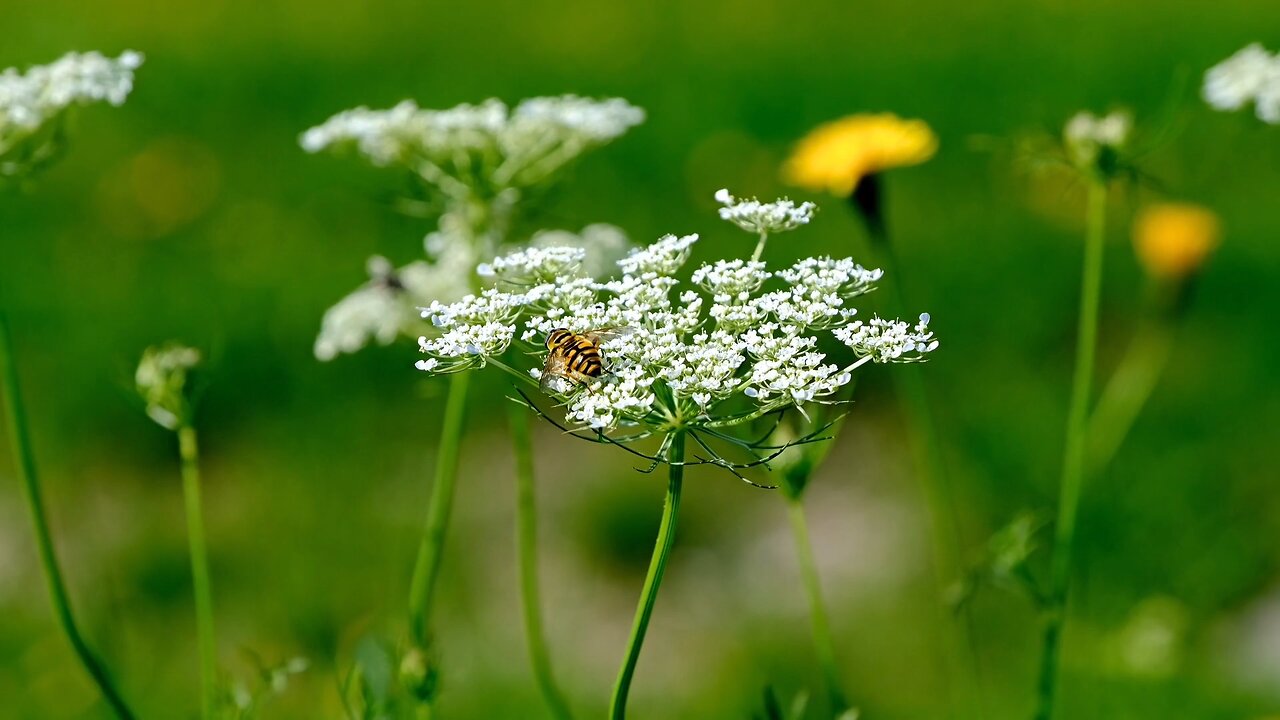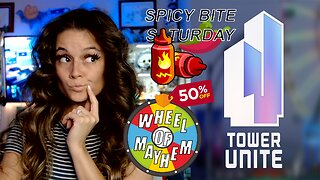Premium Only Content

"Exploring Wild Carrot: Nature’s Lacework in Bloom"
Wild carrot (*Daucus carota*), also known as Queen Anne's lace, is a flowering plant in the Apiaceae family, which also includes parsley, celery, and fennel. It is the ancestor of the cultivated carrot, and it grows widely in many regions as a wildflower. Here’s more about wild carrot:
### Botanical Description:
- **Appearance:** Wild carrot is a biennial plant that grows up to 1 to 4 feet tall. In its first year, it produces a rosette of feathery, finely divided leaves. In the second year, it sends up a flowering stalk.
- **Flowers:** The plant is known for its umbrella-shaped clusters of tiny white flowers, called umbels. These umbels often have a small, dark purple or red flower in the center, which is thought to attract pollinators. The flowers bloom from early summer to early fall.
- **Leaves:** The leaves are finely divided and fern-like, similar to those of the cultivated carrot. They have a distinctive carrot-like smell when crushed.
- **Roots:** The root is a slender, white taproot that has a strong, carroty odor but is tough and fibrous, unlike the tender roots of the cultivated carrot.
### Habitat and Distribution:
- **Native Range:** Wild carrot is native to Europe and parts of Asia but has naturalized in many regions of North America and other parts of the world.
- **Habitat:** It thrives in a variety of habitats, including fields, meadows, roadsides, and disturbed areas. It prefers well-drained soil and full sun but can grow in partial shade.
- **Invasiveness:** In some regions, wild carrot is considered invasive because it can quickly colonize open areas and outcompete native plants.
### Uses:
- **Culinary:** While the root of wild carrot is technically edible, it is generally not eaten due to its toughness and bitterness. However, the young leaves and flowers can be used sparingly in salads or as a garnish. The seeds have been used as a spice and were historically used in traditional medicine.
- **Medicinal:** Wild carrot has a history of use in herbal medicine, where it was traditionally used as a diuretic, a digestive aid, and for its purported contraceptive properties. However, caution is advised as the plant contains compounds that can be toxic in large amounts.
- **Pollinators:** The flowers attract a variety of pollinators, including bees, butterflies, and other insects, making it a beneficial plant in wildflower gardens.
### Caution and Toxicity:
- **Confusion with Poisonous Plants:** Wild carrot bears a close resemblance to some highly toxic plants, such as poison hemlock (*Conium maculatum*) and water hemlock (*Cicuta* spp.), which can be deadly if ingested. It's essential to correctly identify wild carrot before using it.
- **Skin Irritation:** The plant can cause skin irritation or photodermatitis in some individuals, especially when handled on sunny days.
### Historical and Cultural Significance:
- **Queen Anne’s Lace:** The plant is commonly called Queen Anne's lace due to the lacy appearance of its flower heads. According to legend, the central purple flower represents a drop of blood from Queen Anne of England, who pricked her finger while making lace.
- **Ancestry of Cultivated Carrot:** Wild carrot is the wild ancestor of the domesticated carrot. The cultivated varieties were developed over centuries for their sweeter, larger, and more tender roots, which are a staple in modern cuisine.
### Ecological Importance:
- **Wildlife:** Wild carrot provides habitat and food for various insects and birds. The dried flower heads often persist into winter, offering shelter for small insects.
Wild carrot is a fascinating plant with a rich history and an important role in the natural world. However, it should be approached with care due to its resemblance to poisonous species.
-
 DVR
DVR
DLDAfterDark
5 hours ago $0.11 earnedDLD Live! Feat. Red Dawn Readiness! Glock FRT's - Striker Fire Safety Concerns - ACE Trigger
11.4K1 -
 DVR
DVR
BlackDiamondGunsandGear
4 hours agoAre ALL Striker Fired Pistols UNSAFE? // After Hours Armory
27K4 -
 6:34:50
6:34:50
SpartakusLIVE
8 hours ago#1 Saturday Spartoons on RUMBLE PREMIUM
102K6 -
 1:04:59
1:04:59
Man in America
9 hours ago“Summoning the Demon” — The AI Agenda Is FAR WORSE Than We Know w/ Kay Rubacek
34.7K20 -
 2:16:48
2:16:48
Tundra Tactical
7 hours ago $0.07 earned🎯💥 The World’s Okayest Gun Show 🔫😂 | LIVE Tonight on Rumble!
20.2K -
 3:36:03
3:36:03
Mally_Mouse
1 day ago🌶️ 🥵Spicy BITE Saturday!! 🥵🌶️- Let's Play: Tower Unite!
43.6K2 -
 58:59
58:59
MattMorseTV
7 hours ago $1.27 earned🔴Trump just BROKE Newsom.🔴
59.9K65 -
 18:14
18:14
Her Patriot Voice
7 hours agoWho Is WORSE for NYC: Trump Girl or Socialist?
39.6K28 -
 3:39:42
3:39:42
SavageJayGatsby
6 hours agoSpicy Saturday with Mally! | Road to 100 | $300 Weekly Goal for Spicy Bites!
41.5K1 -
 3:35:50
3:35:50
FomoTV
8 hours ago🚨 Swamp Theater: FBI Raids Bolton 🕵 Still NO Epstein Files, Trump's Troops & the Red Heifer Hoax 🐂 | Fomocast 08.23.25
17.7K3